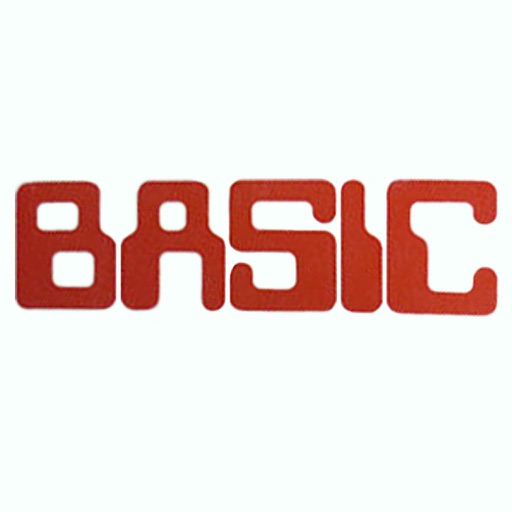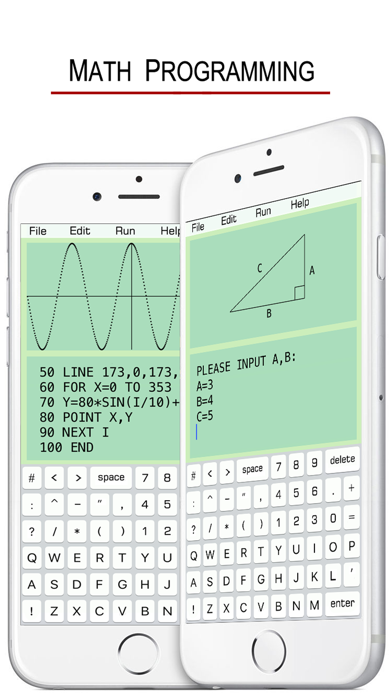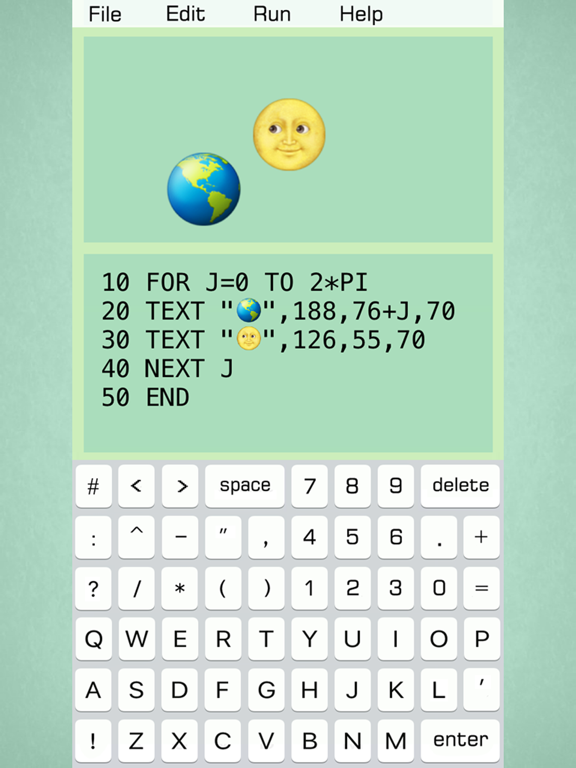
BASIC - Programming Language ! Let's Code !
See also: Top 20 alternatives to BASIC - Programming Langu
4 votes - Education - First release: 2016-09-15T08:02:51Z
Screenshots
Description - 4+
BASIC: THE FEELING OF THE GOOD OLD TIMES !
10 INPUT A
20 B = SIN(A)
30 PRINT "ANSWER: ", B
40 END
BASIC USER'S GUIDE:
• PRINT
10 PRINT "HELLO WORLD !"
20 END
• INPUT
10 INPUT “A=”, A
20 PRINT A
30 END
• IF...THEN...
Number Comparison:
10 INPUT A
20 IF A>90 THEN B=“A”
30 PRINT B
40 END
Conditional Operators:
> greater than
< less than
>= greater than or equal to
=> equal to or greater than
<= less than or equal to
=< equal to or less than
= equal to
== equal to
<> not equal to
!= not equal to
THEN can be followed by GOTO, GOSUB, INPUT, PRINT.
String Comparison:
10 INPUT A
20 IF A=“TOM” THEN PRINT “BOY”
30 END
Conditional Operators:
= is
== is
<> is not
!= is not
• FOR...NEXT...
10 FOR I=1 TO 4 STEP 2
20 PRINT “HELLO”, I
30 NEXT I
40 END
STEP specifies the counter increment for each loop. If STEP doesn’t exit, the default increment is 1.
FOR...NEXT... loop can be nested.
10 FOR I=1 TO 5
20 FOR J=1 TO 4
30 PRINT I, J
40 NEXT J
50 NEXT I
60 END
• GOTO
10 ...
20 ...
30 ...
40 GOTO 10
50 ...
• GOSUB
10 PRINT “H”
20 GOSUB 100
30 PRINT “L”
40 END
100 PRINT “A”
110 RETURN
• SOUND
10 SOUND C, M, 0.5
The line 10 plays Middle C piano note for 0.5 seconds.
Note: C, C#, D, D#, E, F, F#, G, G#, A, A#, B
Pitch Range: L (low), M (middle), H (high)
Lasting Time: specifies how long a note lasts.
C, D, E, F, G, A, B can also be labeled as 1, 2, 3, 4, 5, 6, 7. (C# as 1#).
• TEXT
10 TEXT “HELLO”, x, y, size
(x,y): position of the string “HELLO”.
• CIRCLE
10 CIRCLE x, y, radius
(x,y): the center of the circle.
• RECTANGLE
10 RECT x, y, width, height
(x,y): top-left point of the rectangle.
• LINE
10 LINE x1, y1, x2, y2
(x1,y1): the starting point of the line.
(x2,y2): the ending point of the line.
• POINT
10 POINT x, y
(x,y): the position of the point.
• CLR: clear the edit window.
• CLS: clear the graph window.
• DELAY
10 DELAY 0.5
0.5:lasting time in seconds
This function is used to suspend execution of a program for a particular time.
• CURVE
10 CURVE x, y, radius, 0, PI
0: starting angle
PI: ending angle
The curve draws clockwise with center (x,y).
• Mathematical Functions:
SIN(X), COS(X), TAN(X), COT(X),
ASIN(X), ACOS(X), ATAN(X),
SINH(X), COSH(X), TANH(X),
ASINH(X), ACOSH(X), ATANH(X).
SQR(X): square root of x.
ABS(X): absolute value of x.
FCT(X): x factorial.
LOG(X): natural logarithm of x.
LOG10(X): base-10 logarithm of x.
LOG2(X) :base-2 logarithm of x.
EXP(X): base-e exponential of x.
ERF(X): the error function of x.
ERFC(X): the complementary error function of x.
ROUND(X) :integral nearest to x.
CEIL(X): the smallest integral that is not less than x.
FLOOR(X): the largest integral that is not greater than x.
TGAMMA(X): the gamma function of x.
LGAMMA(X): the natural logarithm of the absolute value of the gamma function of x.
• Reserved Variables:
INKEY : once a key is pressed, the value of INKEY changes.
RND : a random number.
PI : π
• Some Tips:
1. Undo & Redo typing on iPhone with a shake.
2. Copy an Emoji or some character from other places (like Notes), then paste them on the edit window.
3. Exponentiation is expressed as X^Y.









